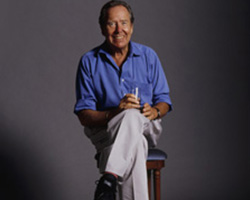
Lord Snowdon
2007 Honoree / Achievement In Portraiture
LORD SNOWDON once said, “I am always suspicious of photographs that are too beautiful”. His images of the socially prominent and of the world of fashion often graced the pages of such magazines as Vanity Fair, Vogue, London’s Telegraph and House and Garden –prompting its readers to see Snowodn’s witty yet sensitive portrayal of these often famous figures.
Although Snowdon studied architecture at Cambridge, it was photography that would be his calling in life. With the encouragement of his stage designer/ artist uncle (the famed Oliver Messel), Snowdon began taking photographs of people in the theater. This soon led to his use of a miniature camera that allowed Snowdon to revolutionize the “stuffy” British world of photography with his intimate, intense and candid portraiture of artists, writers, actors and designers.
As Sonwdons career as a photographer flourished, he continued to capture the artistic and creative vitality of London whilst also receiving accolades for his royal studies. One of the Royals whom he photographed would be his future sister-in-law – Queen Elizabeth II (Lord Snowdon married Princess Margaret in 1960).
In the time that followed, Lord Snowdon also became the picture editor for The Sunday Times Magazine (1960), which sealed his reputation as on of Britain’s most respected photographers. In 1961 he was created Earl of Snowdon and has since gone on to become renowned for his work as a designer, writer, Emmy Award-winning film maker, designer of theater seats, skiwear, clocks, furniture and motorized wheelchairs. In addition, from 1960 – 1963 he co-designed with Frank Newby and Cedric Price – the aviary of the London Zoo.
It is interesting to note that throughout his career as a photographer, Lord Snowdon also played a key role as a lobbyist for equal opportunities for the disabled. He often captured inner city life and people who were mentally ill through documentary style photographs that elucidated Snowdon’s compassion and genuine interest in his subjects. He has since gone on to have numerous books published of his work and in 2001 he was the subject of a career retrospective at the National Portrait Gallery, which then traveled to the Yale Center for British Art.
